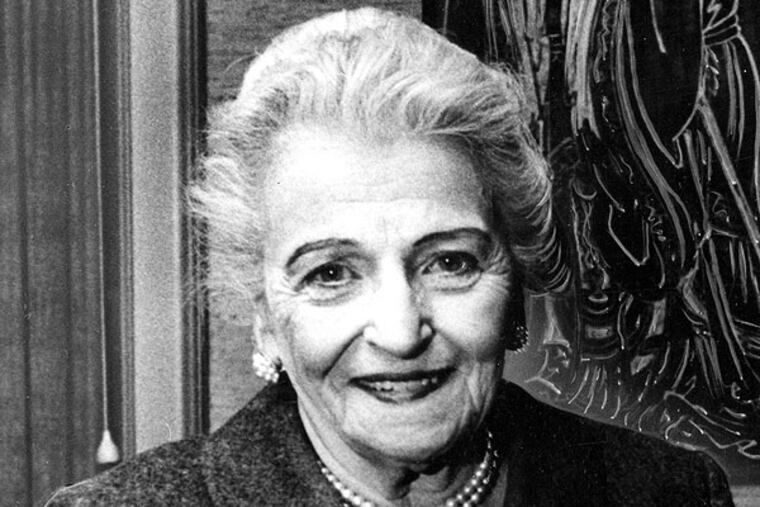Unknown Pearl S. Buck novel turns up in Texas
"It was a scenario right out of Storage Wars." Michael Carlisle of InkWell Management in New York represents the estate of Pearl S. Buck, the Nobel Prize-winning author of The Good Earth who lived much of her life in Bucks County. He is trying to describe the moment a previously unknown Buck novel was discovered in a storage unit in, of all places, Texas.

"It was a scenario right out of Storage Wars."
Michael Carlisle of InkWell Management in New York represents the estate of Pearl S. Buck, the Nobel Prize-winning author of The Good Earth who lived much of her life in Bucks County. He is trying to describe the moment a previously unknown Buck novel was discovered in a storage unit in, of all places, Texas.
As announced Wednesday, the novel, titled The Eternal Wonder, will be published, in digital and paperback editions, on Oct. 22 by Open Road Integrated Media of New York. It will join 28 other Buck titles Open Road is making available in e-editions.
Much is mysterious about the origin and odyssey of the handwritten manuscript, but what's known does sound like an episode of Storage Wars, the A&E reality TV show.
According to Carlisle, a woman in Texas found two boxes in a storage unit: "She was literate enough to see the name 'Pearl S. Buck' on the manuscript and know this might be something valuable. It could have been thrown out; it could have been thrown in a Dumpster. It wasn't."
Instead, the woman contacted Pearl S. Buck International (PSBI). PSBI referred the matter to the Buck family trust, administered by Edgar S. Walsh, one of Buck's sons. The trust acquired the manuscript for a small sum. Walsh worked with experts to authenticate the manuscript. "I recognized her handwriting immediately," he says by phone. "I realized I was looking at a historic document, and I was absolutely amazed that in the last year of her life, my mother was able to produce a finished literary work such as this." (According to Carlisle, the manuscript was dated.)
For most of her first 40 years, Buck lived the life of a missionary and teacher in China. She witnessed years of social upheaval, an experience that made her stand out among American writers. She lived on Green Hills Farm in Perkasie, Bucks County, from 1933 to 1973; her house is now a National Historical Landmark. Her grave site is also there.
Buck's best-known novel, The Good Earth, was published in 1931 and topped the U.S. best-seller lists for two years. Told with deep knowledge of China, epic sweep, and humanitarian earnestness, this tale of people such as farmer Wang Lung during drought times and social turmoil helped earn her the Pulitzer Prize in 1932 and the Nobel Prize in 1938. As of 1939, it was the first U.S. mass-market paperback, starting on the shelves of Macy's department store. Buck was incredibly prolific, publishing more than 80 books and hundreds of essays.
She died in Danby, Vt., in 1973, leaving her estate in disarray. "At that time," Carlisle says, "there was a great deal of confusion, and much of her property was either stolen or otherwise dispersed." There was no record of the Eternal Wonder manuscript, and it's not known how it ended up in Texas.
Friedman says she finds The Eternal Wonder "completely hypnotic. It is moving and a real page-turner." The protagonist is a brilliant writer named Randolph Colfax, whose story takes him to New York, Paris, and to Korea, on a mission patrolling the demilitarized zone.
The style, Friedman says, "is not contemporary, but the style of Buck's era. Her great themes, her interest in Korea and China, her epic scale, that's there. I was completely taken by the story."
Pam Carroll, marketing manager for Pearl S. Buck International in Perkasie, says: "We're thrilled by this announcement. Her many fans will have something new to read and explore." Carroll sees many fortunate connections: After being closed for six months for restorations, Buck's house will reopen on her birthday, June 26. "This find makes it a special birthday celebration," Carroll says.
Peter Conn, professor of English at the University of Pennsylvania, is author of Pearl S. Buck: A Cultural Biography. "Her later writing is much less interesting than the provocative writing she did in The Good Earth and other work in the 1930s, for which I don't think she gets enough credit," he says. Buck's work "spoke to the growing U.S. awareness of Asia, and the growing sense of social obligation in literary writing at the time."
Although her esteem in critical circles declined throughout the late 20th century, interest in Buck, and especially The Good Earth, remains high. It didn't hurt that Oprah Winfrey selected it for her influential book club in 2004.
Conn says: "It's remarkable: In the short time since the announcement about [The Eternal Wonder], there have been articles in the Christian Science Monitor, the Huffington Post, ABC, and the New York Times. There's still a lot of interest. And I'll be interested to see what's in this new novel."
Friedman says that the new Buck e-editions are getting good comments from readers, especially The Good Earth, a popular title for reading groups.
"There are still a lot of people," Friedman says, "who will tell you, 'Pearl S. Buck changed my life.' "